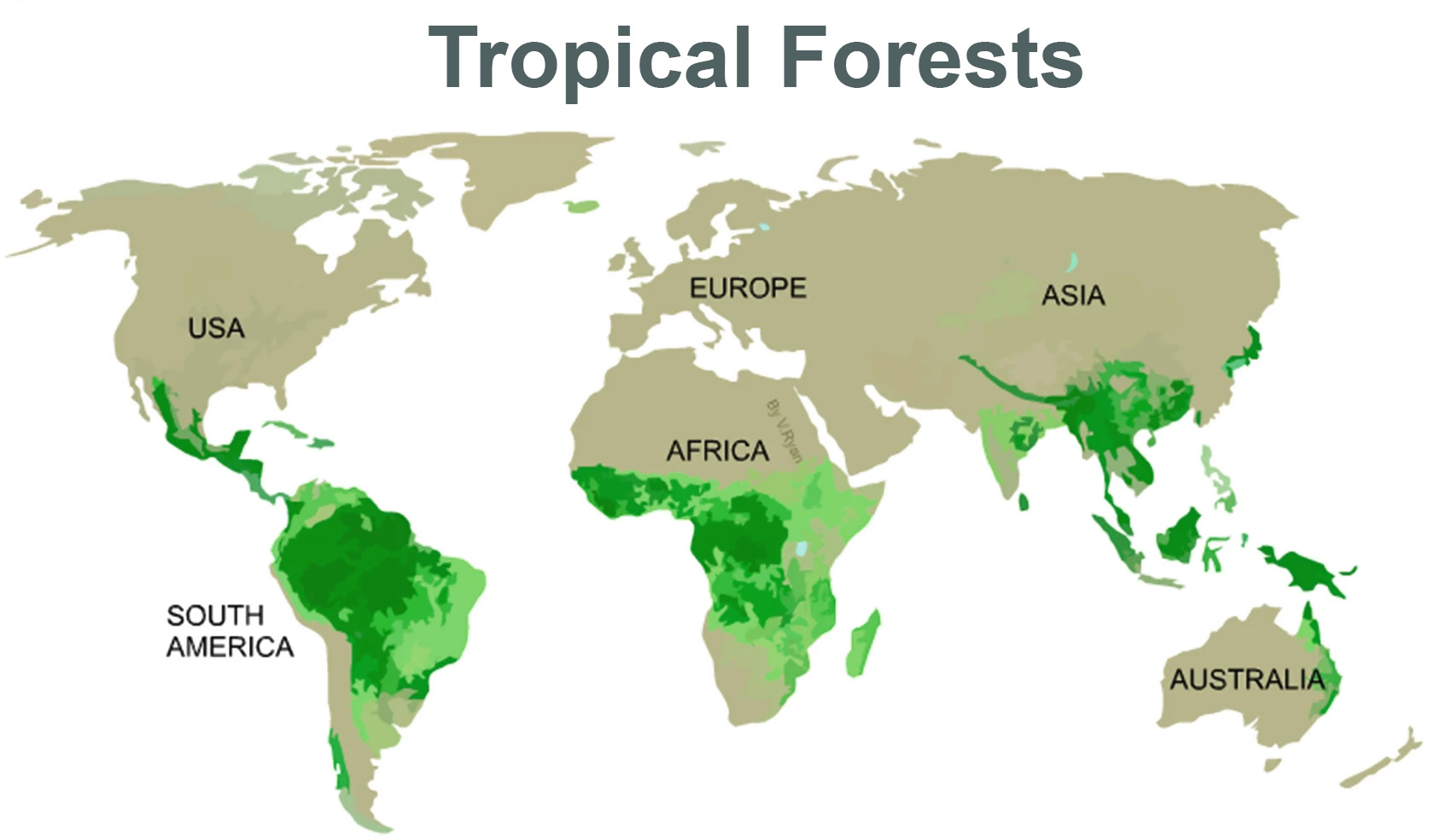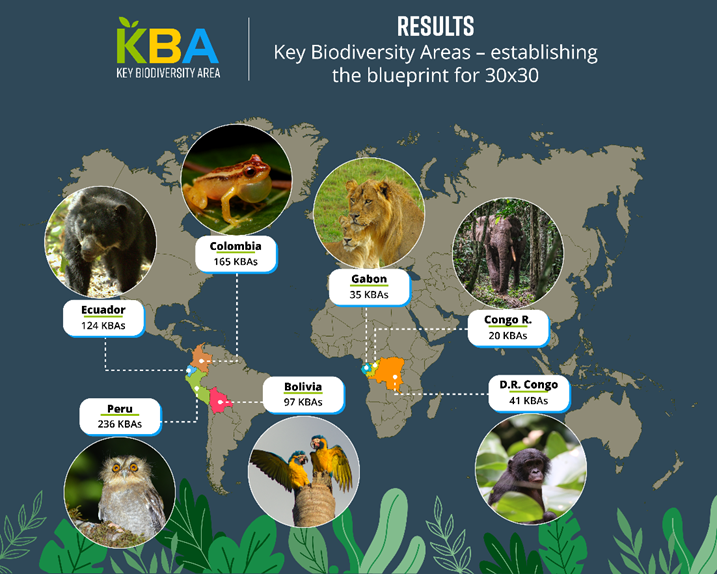Warming of Key Biodiversity Areas (KBAs) | 19 Oct 2024
For Prelims: Key Biodiversity Areas (KBAs), Kunming-Montreal Global Biodiversity Framework, Andes Mountains, Tropical Forests, BirdLife International, Important Bird and Biodiversity Areas (IBA), World Conservation Congress, International Union for Conservation of Nature (IUCN), Key Biodiversity Areas Partnership, Rainforests, Mangroves, Carbon Sequestration, Nutrient Cycling.
For Mains: Effect of global warming and climate change on Key Biodiversity Areas (KBAs) in tropical ecosystems, Measures need to halt tropical ecosystem degradation.
Why in News?
Recently, a study has shown that key biodiversity areas (KBAs) in tropical forests have transitioned to new temperature regimes (higher temperature) due to global warming and climate change.
- The Kunming-Montreal Global Biodiversity Framework aims to conserve at least 30% of the world's land by 2030, with Key Biodiversity Areas (KBAs) as a core priority.
Note:
- Tropical rainforests are dense and warm forests typically found between 23.5 degrees to the north and south of the Equator.
What is the Kunming-Montreal Global Biodiversity Framework (KMGBF)?
- About: It is a multilateral treaty aimed at halting and reversing biodiversity loss globally by 2030. It was adopted in December 2022 during the 15th meeting of the Conference of the Parties (CoP) of UN CBD.
- Purpose and Goals: It ensures that by 2030 at least 30% of areas of degraded terrestrial, inland water, and marine and coastal ecosystems are under effective restoration.
- It has 23 action-oriented global targets for urgent action over the decade to 2030 with Key Biodiversity Areas (KBAs) as a core priority.
- Long-Term Vision: The framework envisions that by 2050, there will be a collective commitment to living in harmony with nature, serving as a foundational guide for current actions and policies on biodiversity conservation and sustainable use.
What are Key Highlights of the Study?
- Temperature Changes in KBAs: Up to 66% of tropical forest KBAs have entered a new phase characterised by new mean annual temperature regimes.
- Regional Temperature Shifts: The percentage of Key Biodiversity Areas (KBAs) experiencing temperature changes was 72% in Africa, 59% in Latin America, and 49% in Asia and Oceania.
- However, in Asia and Oceania, 12% of KBAs have not transitioned to the new temperature scenario though 23% of these are unprotected.
- Vertical Temperature Change: The environment beneath the forest canopy is climatically stable, with less temperature variation than in open habitats.
- Disproportionate Impact: Some KBAs in Latin America (2.9%) and Asia and Oceania (0.4%) have shifted to nearly entirely new temperature conditions, with over 80% of measurements falling outside their previous ranges.
- These include areas in the tropical Andes Mountains in Ecuador, Colombia, Venezuela, and Panama.
- Stable KBAs: Around 34% of tropical forest KBAs have not yet experienced new temperature pattern, and over half of these are under some form of protection.
- Northern Australia's tropical forests are among the least affected by novel temperature conditions.
What are Key Biodiversity Areas (KBAs)?
- Origin of the Concept: BirdLife International initiated the idea by identifying Important Bird and Biodiversity Areas (IBA). The success of this model led to the inclusion of other taxonomic groups, such as plants, butterflies, and freshwater and marine biodiversity.
- At the World Conservation Congress in Bangkok in 2004, the International Union for Conservation of Nature (IUCN) recognized the need for a unified framework, which culminated in the 2016 global KBA Standard.
- About KBAs: KBAs are sites contributing significantly to the global persistence of biodiversity.
- They may contain unique species or species found only in limited areas, and are critical for the planet’s health.
- Criteria for Recognition: There are 11 criteria grouped under five categories that a site must meet to qualify as a KBA. These categories are:
- Threatened biodiversity
- Geographically restricted biodiversity
- Ecological integrity
- Biological processes
- Irreplaceability
- Global KBA Presence: To date, more than 16,000 KBAs have been mapped worldwide.
- The Key Biodiversity Areas Partnership, comprising 13 global conservation organisations, is working to identify, map, and conserve KBAs across the globe.
- India has 862 Key Biodiversity Areas (KBAs), which are crucial for the conservation of biodiversity E.g., Western Ghats.
- The Key Biodiversity Areas Partnership, comprising 13 global conservation organisations, is working to identify, map, and conserve KBAs across the globe.
What are the Impacts of Rising Temperatures on Tropical Forests and KBAs?
- Disruption of Stable Microclimates: Sudden changes can exceed their thermal tolerance, leading to stress or mortality. Species that occupy specific niches within stable microclimates may face habitat loss or degradation.
- Threat to Biodiversity: Increased temperatures can lead to habitat degradation, particularly in sensitive ecosystems like rainforests, mangroves, and coral reefs.
- Alteration of Ecosystem Services: Rising temperatures can impair ecosystem services such as carbon sequestration, water regulation, and nutrient cycling.
- Threat of Invasive Species: Warmer temperatures may allow invasive species to thrive and outcompete native species.
- Deforestation and Degradation: Higher temperatures may exacerbate deforestation and forest degradation by making ecosystems more vulnerable to fires, pests, and diseases.
- Shifts in Species Composition: Many species may migrate towards higher altitudes or latitudes in search of cooler conditions leading to local extinction of species.
- Impacts on Human Communities: Rising temperatures can affect forest productivity threatening the livelihood of indigenous and local communities dependent on tropical forests for food, medicine, and shelter.
How to Protect Key Biodiversity Areas from Rising Temperatures?
| Develop and Scale Up Nature-based Solutions | Leverage ecosystems to mitigate climate change effects while avoiding maladaptive practices like monoculture plantations and focusing on diverse, resilient ecosystems. |
| Restore Ecosystems | Prioritise the protection and restoration of forests, wetlands, peatlands, and mangroves to enhance carbon sequestration and biodiversity. |
| Rewilding Initiatives | Explore rewilding strategies, including the reintroduction of native species, to restore ecosystems. |
| Habitat Connectivity Initiatives | Create corridors to connect fragmented habitats, allowing species to migrate and adapt to changing climatic conditions. |
| Invasive Species Management | Monitor and inspect goods (plants, animals, soil) at borders to prevent the introduction of invasive species and introduce natural predators that specifically target the invasive species. |
|
Drishti Mains Question: What are Key Biodiversity Areas (KBAs)? How are they impacted by global warming and climate change? |
UPSC Civil Services Examination Previous Year Question (PYQ)
Prelims
Q.“Momentum for Change: Climate Neutral Now” is an initiative launched by (2018)
(a) The Intergovernmental Panel on Climate Change
(b) The UNEP Secretariat
(c) The UNFCCC Secretariat
(d) The World Meteorological Organisation
Ans: (c)
Q. With reference to ‘Global Environment Facility’, which of the following statements is/are correct?(2014)
(a) It serves as financial mechanism for ‘Convention on Biological Diversity’ and ‘United Nations Framework Convention on Climate Change’
(b) It undertakes scientific research environmental issues at global level
(c) It is an agency under OECD to facilitate the transfer of technology and funds underdeveloped countries with specific aim to protect their environment
(d) Both (a) and (b)
Ans: (a)
Mains
Q. How is the Government of India protecting traditional knowledge of medicine from patenting by pharmaceutical companies? (2019)


